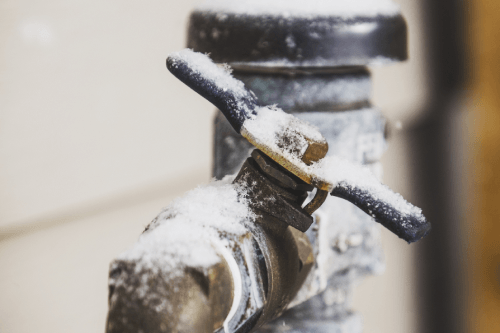What're your thoughts on How to Prevent Your Pipes From Freezing?

Winter can ruin your pipes, specifically by freezing pipes. Right here's just how to prevent it from happening and what to do if it does.
Introduction
As temperature levels drop, the threat of frozen pipes rises, possibly bring about costly repairs and water damage. Recognizing how to prevent icy pipelines is vital for home owners in chilly environments.
Prevention Tips
Protecting at risk pipelines
Cover pipes in insulation sleeves or make use of warmth tape to shield them from freezing temperatures. Focus on pipes in unheated or outside locations of the home.
Heating techniques
Maintain interior spaces effectively heated up, particularly areas with pipes. Open cupboard doors to permit warm air to flow around pipes under sinks.
Exactly how to determine icy pipes
Try to find decreased water flow from taps, uncommon odors or sounds from pipelines, and noticeable frost on exposed pipes.
Long-Term Solutions
Architectural adjustments
Think about rerouting pipes away from outside walls or unheated areas. Add additional insulation to attic rooms, cellars, and crawl spaces.
Upgrading insulation
Invest in top quality insulation for pipelines, attics, and walls. Proper insulation aids maintain constant temperatures and minimizes the risk of frozen pipes.
Protecting Exterior Pipes
Garden tubes and exterior faucets
Disconnect and drain pipes garden pipes prior to winter season. Install frost-proof faucets or cover outdoor taps with protected caps.
Comprehending Icy Pipes
What causes pipes to ice up?
Pipelines ice up when revealed to temperatures listed below 32 ° F (0 ° C) for expanded periods. As water inside the pipelines freezes, it broadens, taxing the pipeline wall surfaces and possibly causing them to burst.
Threats and damages
Frozen pipes can lead to water supply disruptions, home damage, and expensive repair work. Ruptured pipelines can flood homes and create considerable architectural damages.
Indicators of Frozen Piping
Recognizing frozen pipes early can stop them from bursting.
What to Do If Your Pipes Freeze
Immediate activities to take
If you believe icy pipes, keep taps open to eliminate stress as the ice thaws. Utilize a hairdryer or towels soaked in hot water to thaw pipes gradually.
Verdict
Preventing frozen pipelines calls for positive measures and quick feedbacks. By recognizing the causes, indications, and safety nets, homeowners can shield their plumbing throughout winter.
6 Proven Ways to Prevent Frozen Pipes and Protect Your Home
Disconnect and Drain Garden Hoses
Before winter arrives, start by disconnecting your garden hoses and draining any remaining water. Close the shut-off valves that supply outdoor hose bibs and leave the outdoor faucet open to allow any residual water to drain. For extra protection, consider using faucet covers throughout the colder months. It’s also important to drain water from any sprinkler supply lines following the manufacturer’s directions.
Insulate Exposed Pipes
Insulating your pipes is an effective way to prevent freezing. Pipe insulation is readily available at home improvement stores and is relatively inexpensive. Pay close attention to pipes in unheated areas such as the attic, basement, crawl spaces, or garage. Apply foam insulation generously to create a buffer against the cold. You can also wrap your pipes in heat tape or thermostat-controlled heat cables for added warmth.
Seal Air Leaks
Inspect your home for any cracks or openings that could let in cold air. Seal any holes around the piping in interior or exterior walls, as well as the sill plates where your home rests on its foundation. Additionally, make sure to keep your garage door closed unless you’re entering or exiting. Leaving it open creates a significant air leak that can lead to frozen pipes.
Allow Warm Air Circulation
During cold snaps, it’s essential to allow warm air to circulate evenly throughout your home. Leave interior doors ajar to promote better airflow. Open kitchen and bathroom cabinets to help distribute heat consistently around the rooms. If you have small children or pets, be sure to remove any household chemicals or potentially harmful cleaners from open cabinets for safety.
Let Faucets Drip
A small trickle of water can make a big difference in preventing ice formation inside your pipes. When temperatures drop significantly, start a drip of water from all faucets served by exposed pipes. This continuous flow helps prevent the water from freezing. Additionally, running a few faucets slightly can relieve pressure inside the pipes, reducing the chances of a rupture if the water inside does freeze.
https://choateshvac.com/6-proven-ways-to-prevent-frozen-pipes-and-protect-your-home/

Do you enjoy reading up on Winter Plumbing Precautions: Preventing Frozen Pipes? Post a short review down below. We will be happy to hear your views about this write up. In hopes that you come back again before long. Liked our article? Please share it. Help someone else discover it. Many thanks for taking the time to read it.
Schedule
 Scott Baio Then & Now!
Scott Baio Then & Now! Brandy Then & Now!
Brandy Then & Now! Michael Jordan Then & Now!
Michael Jordan Then & Now! Sydney Simpson Then & Now!
Sydney Simpson Then & Now! Bill Cosby Then & Now!
Bill Cosby Then & Now!